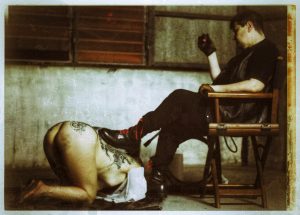Sadism, as I practice it, is not conquest, domination, or hunger. It’s a structured offering – a crafted space where sensation becomes a language. Pain isn’t the goal; clarity is. I don’t escalate just for escalation’s sake. I don’t chase reactions or lean on my own restraint like a leash. I stay present, sharp, fully aware of where I am at every step. It’s never about controlling myself. It’s about being ready to listen – to you.
1. Sadism as Precision, Not Conquest
When I share intimate spaces with you, I listen first: to your body, to your mind underneath it, to the tension threading through both. Your body speaks long before your mouth does. Sometimes you hold still when you process pain – your breathing deepens, your muscles tighten or soften slightly. I watch for the tiny shifts: a flex of a hand, a change in the cadence of breath. Other times you move through it – curling your toes in pleasure, rolling your shoulder blades in overwhelm. No two bodies speak the same way. Learning your language is part of the work. Part of the privilege.
Pain isn’t something I inflict blindly. It’s something I offer – and you either receive it or you don’t. The build isn’t automatic. It’s earned moment by moment, through real-time listening. Through watching how much of yourself you’re willing – or able – to bring forward.
And there’s a tension I watch for. Not the tension of endurance, or resistance. The tension of trust forming. Early on, you walk the fringes with me: drawn toward what I offer, but holding back, not fully ready to hand yourself over. You want the sensation. You want more. But trust moves slower than want. That stretched line – that razor edge between wanting and fearing – is where truth lives.
And then, one time, it happens: you lean. You let me see you. You trust me to hold you in the pain without dropping you. Not catching you like you’re falling apart – but giving you something solid to lean into while you stretch yourself open. That’s the real moment. That’s where truly begin talking.
Sadism, for me, isn’t power. It’s presence sharpened into exactness. And when you trust me enough to meet me there – that’s when it’s real.
2. Pain as an Offering, Not an Attack
Pain, in my practice, is never forced. It’s offered. Something you choose to take – consciously, willingly, with full awareness of what it means. I am not there to overwhelm you. I am not there to conquer you. Pain, for me, is another language – one I communicate in, as naturally as others use words.
That choice starts before the first strike ever lands. I make sure you’re risk-aware. I give you real information: about the tools I use, about the risks they carry, about my level of skill, about what I know and what I cannot guarantee. I strip out the spaces where fantasy might creep in and twist expectations. I want your decision to engage with me to be a clear, informed one – not something fueled by assumptions you don’t even realize you’re carrying.
Once we step into the scene, the offering doesn’t stop. I don’t just monitor your words. I listen to your body – because your body never lies. Breathing, tension, movement – they tell me more than your mouth ever could. I know how to tell hurt from harm. Hurt has flow; harm fractures or dulls. As long as your body keeps choosing to meet me, even through strain, even through struggle, I know consent is alive between us.
Over time, when trust builds, the resonance deepens. I can anticipate your reactions to a new toy, a new rhythm, a new push – not because you’re predictable, but because you’ve trusted me enough to let your body teach me. And when your body confirms what I read, it’s not dominance. It’s connection. It’s conversation.
Pain is not something I throw at you. It’s something I offer with both hands open. You choose whether to reach for it.



